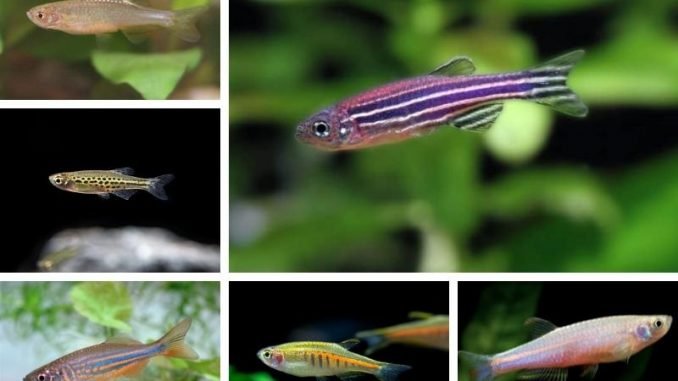
The danio is a genus of freshwater fish that belongs to the Cyprinidae family. Native to South and Southeast Asia, danios are playful and social and display shoaling behavior.
Danios are popular with beginner fishkeepers because of the fish’s gentle temperament and ease of care.
Danios are common in the pet trade and most local pet stores carry them. Today, there are 27 recognized types of danio. Below are the most popular types.
TABLE OF CONTENTS
Blue Danio
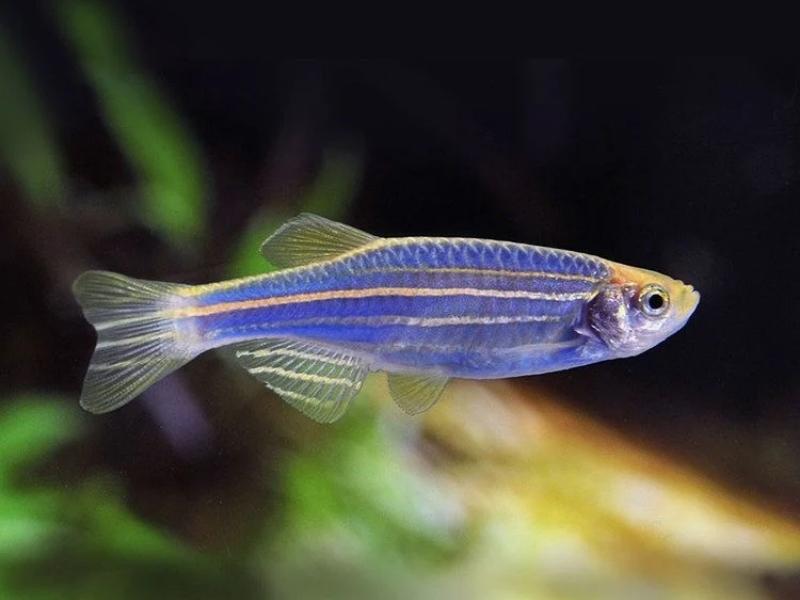
| Care level: | Temperament: | Color: | Lifespan: | Size: |
| Easy | Peaceful | Variable, silvery coloration | Up to 6 years | Up to 2 inches |
| Water temperature: | Water pH: | Tank size: | Diet: | Scientific name: |
| 73 to 77°F | 5 to 7 pH | 10 gallons | Omnivore | Danio kerri |
The blue danio gets its name from its vibrant blue coloration. The fish grows up to 2 inches long and has gold lines that span across its body. Blue danios are primarily found in streams and pools in the Malay Peninsula.
Blue danios are hardy and social fish, and do best in groups of at least six. These fish thrive in clean oxygenated water, so proper filtration and regular weekly water changes are essential.
Blue danios can withstand colder temperatures than most freshwater fish, but 73 to 77°F° is ideal. These fish are curious and enjoy exploring and interacting with other peaceful, social species.
Black-Barred Danio
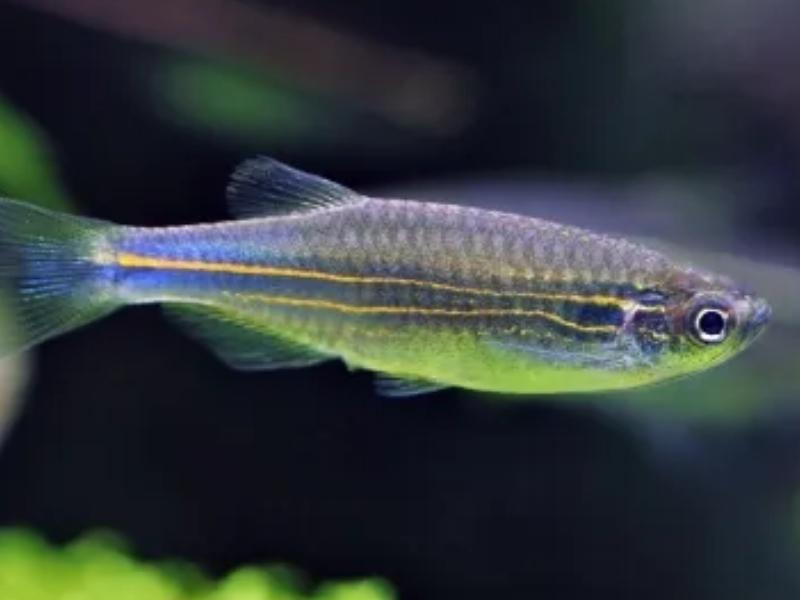
| Care level: | Temperament: | Color: | Lifespan: | Size: |
| Easy | Peaceful | Gray-brown with black bars | 5 years | Up to 3 inches |
| Water temperature: | Water pH: | Tank size: | Diet: | Scientific name: |
| 64 to 79°F | 6.0 to 7.5 pH | 10 gallons | Omnivore | Danio absconditus |
The black-barred danio is one of the largest danio species, reaching up to 3 inches in length. The fish is grayish-brown and has eye-catching, vertical black bars across its body.
Black-barred danios are active, peaceful fish that thrive in groups of ten or more. Although rarely aggressive, black-barred danios are energetic and shouldn’t live in a tank with timid, slow-moving fish.
Black-barred danios are hardy and easy to care for, but these fish are difficult to find in pet stores.
Celestial Pearl Danio
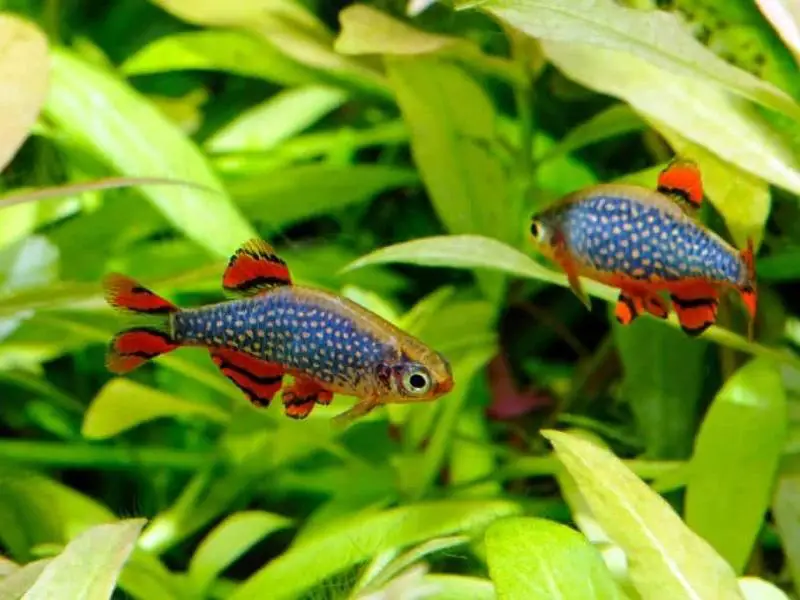
| Care level: | Temperament: | Color: | Lifespan: | Size: |
| Medium | Peaceful, timid | White spots and red fins | 5 years | Up to 1 inch |
| Water temperature: | Water pH: | Tank size: | Diet: | Scientific name: |
| 73 to 79°F | 6.5 to 7.5 pH | 10 gallons | Omnivore | Danio margaritatus |
The celestial pearl danio, also known as the galaxy rasbora, was only recently discovered in 2006.
However, this type of danio gained popularity quickly in the aquarium trade because of its colorful scales and distinct, white-spotted body.
Celestial pearl danios grow up to 1 inch in length. The fish have a blunt snout and vibrant red fins with black stripes.
Celestial pearl danios are from Myanmar and live in densely-vegetated ponds in the wild. These fish prefer to swim at the bottom of the tank.
Celestial pearl danios are peaceful and timid, and require lots of hiding spots and plants to feel at home. Boisterous and fast-swimming species stress out celestial pearl danios.
Dwarf Spotted Danio
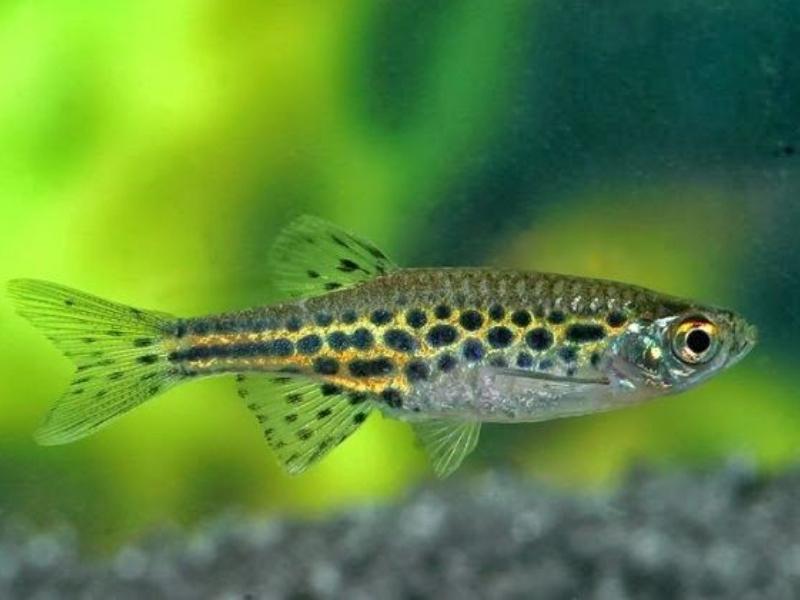
| Care level: | Temperament: | Color: | Lifespan: | Size: |
| Easy | Peaceful, timid | Silver with distinct blue stripe | 3 years | Up to 2 inches |
| Water temperature: | Water pH: | Tank size: | Diet: | Scientific name: |
| 74 to 82°F | 6.5 to 7 pH | 10 gallons | Omnivore | Danio nigrofasciatus |
Dwarf spotted danios have silver bodies with iridescent hues and a blackish blue stripe that spans from gill to tail.
The fish have a row of small spots below the stripe and spots on the anal fin. Dwarf spotted danios natively live in still bodies of water in Myanmar, such as rice paddies and lakes.
Dwarf spotted danios are gentle, but the fish has a shy nature. Avoid keeping this danio with boisterous, lively tankmates.
Keeping dwarf danios in large schools helps these fish to feel safer and more confident. Although low-maintenance, dwarf danios are known to jump out of the tank.
Ensure the tank has a tight, fitted lid. Dwarf danios spend most of their time at the top level of the tank.
Giant Danio
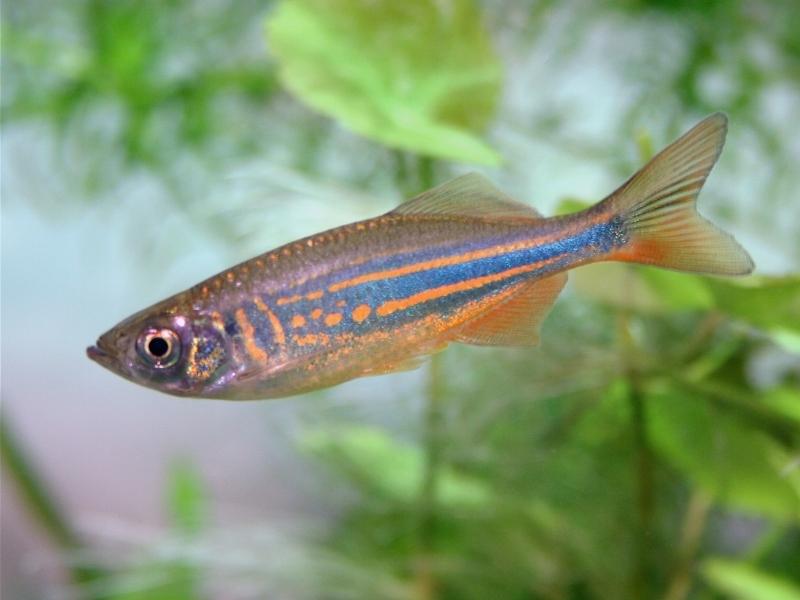
| Care level: | Temperament: | Color: | Lifespan: | Size: |
| Easy | Peaceful | Gold with blue stripes and spots | 5 years | Up to 4 inches |
| Water temperature: | Water pH: | Tank size: | Diet: | Scientific name: |
| 72 to 76°F | 6.5 to 7.5 pH | 20 gallons | Omnivore | Devario aequipinnatus |
The giant danio has a gold, iridescent body with vibrant blue stripes and spots. The tail of the giant danio is forked-shape and the fins are gold and round.
Giant danios grow up to 4 inches in captivity, making the fish one of the largest known danio species.
These fish inhabit fast-flowing, clear streams and rivers, and are found in Sri Lanka, Nepal, Myanmar, Thailand, and India.
Giant danios are active, fast swimmers that prefer the middle and upper levels of the tank. These schooling fish are energetic and playful, and need the company of their own kind to feel at ease.
Glowlight Danio
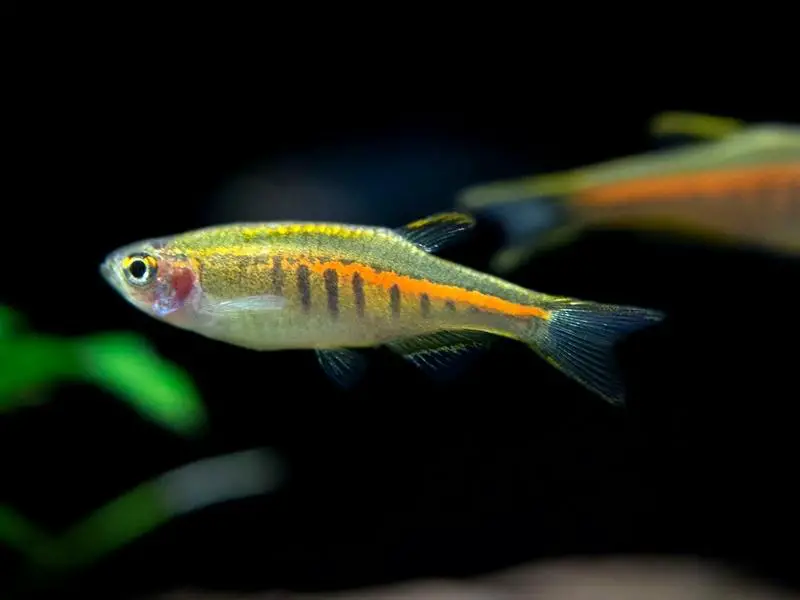
| Care level: | Temperament: | Color: | Lifespan: | Size: |
| Easy | Peaceful | Gold, brown, yellow, red, patterns include spots, bars, and stripes | 5 years | Up to 1.2 inches |
| Water temperature: | Water pH: | Tank size: | Diet: | Scientific name: |
| 66 to 75°F | 6 to 7 pH | 10 gallons | Omnivore | Danio choprae |
The glowlight danio is popular with aquarists because of its striking coloration and patterning. The fish’s body is a vibrant gold, complemented by spots, bars, and stripes of varying hues.
Glowlight danios live in the Irrawaddy River in Myanmar and are accustomed to dense vegetation, rocks, and shallow water.
These fish are lively and docile mid-dwelling fish. Keep them in groups of at least eight.
Add vegetation and rocks to a glowlight danio’s tank to replicate the fish’s natural habitat.
Glowlight danios grow up to 1.2 inches, so the fish aren’t compatible with large fish, which often see small danios as prey.
Gold Ring Danio
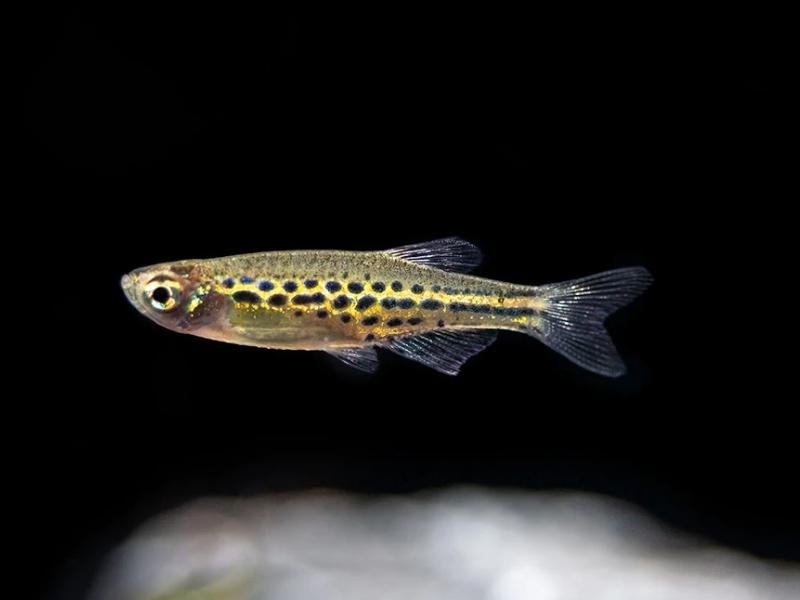
| Care level: | Temperament: | Color: | Lifespan: | Size: |
| Easy | Peaceful | Variable, silvery coloration | 3 years | Up to 1 inch |
| Water temperature: | Water pH: | Tank size: | Diet: | Scientific name: |
| 64 to 80°F | 6 to 7.5 pH | 10 gallons | Omnivore | Brachydanio tinwini |
Gold ring danios are a newly discovered species native to Myanmar. The fish are silvery-gold with distinct blue spots that run across their bodies, and the fins are translucent and spotted.
Gold ring danios are active and swim in the upper and middle levels of the tank. Peaceful and hardy, gold ring danios get along well with similar-sized species.
A spacious tank allows the fish to explore, feel safe, and expel their energy.
Gold ring danios don’t uproot or disturb live plants, making them suitable for densely vegetated tanks. However, open space must be provided for these fast-moving fish to swim freely.
Moustached Danio
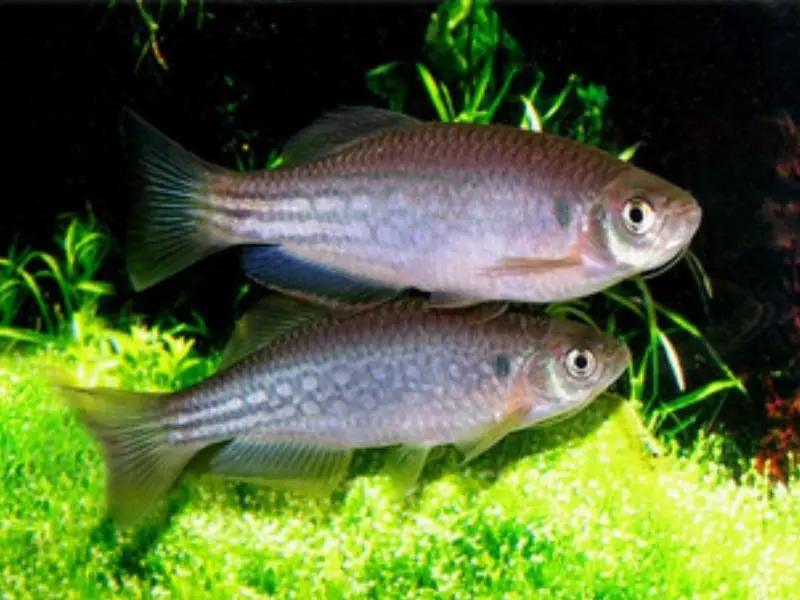
| Care level: | Temperament: | Color: | Lifespan: | Size: |
| Easy | Peaceful | Silver, brown, snakeskin patterning | 4 years | Up to 4 inches |
| Water temperature: | Water pH: | Tank size: | Diet: | Scientific name: |
| 60 to 75°F | 6.5 to 7.5 pH | 20 gallons | Omnivore | Danio dangila |
The moustached danio is a large schooling fish renowned for its unique snakeskin-like patterning and iridescent scales.
The fish gets its name from its unusually long barbels. In the wild, moustached danios inhabit the clear mountain streams of Southeast Asia.
Moustached danios are active fish and vigorous feeders. The fish do best in groups of six or more, and among similar-sized active species. Avoid keeping moustached danios with fin nippers.
The moustached danio is hardy and can acclimatize to a range of water conditions.
Mimic the mustached danio’s natural habitat by using a filter that generates a current, and decorating the tank with vegetation.
Ensure the tank has a secure lid because moustached danios are notorious escape artists.
Panther Danio
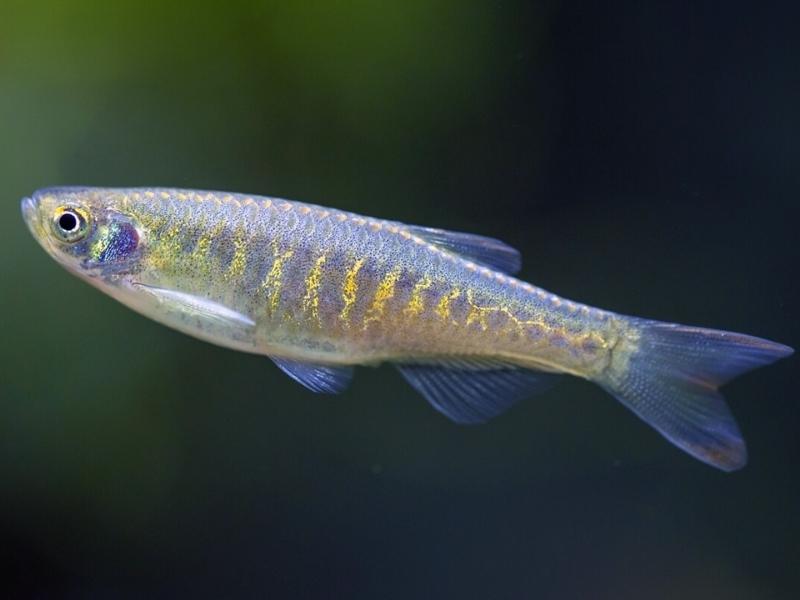
| Care level: | Temperament: | Color: | Lifespan: | Size: |
| Easy | Peaceful, fin nippers | Silver, iridescent, snake-like markings | 4 years | Up to 1.7 inches |
| Water temperature: | Water pH: | Tank size: | Diet: | Scientific name: |
| 72 to 80°F | 6.8 to 7.2 pH | 10 gallons | Omnivore | Danio aesculapii |
The panther danio is a torpedo-shaped small fish that has translucent fins and iridescent scales.
Similar to the moustached danio, the panther danio has snakeskin-like markings across its sides. The panther danio’s scales produce beautiful rainbow hues under a light.
The natural habitat of the moustached danio is clear water forest streams, with a moderate flow and a rocky riverbed. Panther danios require clean and well-oxygenated water to thrive.
Docile and social, panther danios make ideal dither fish, meaning they help other timid fish feel safe and more confident.
However, panther danios are fin nippers. Avoid keeping them with fancy long-finned fish.
Pearl Danio
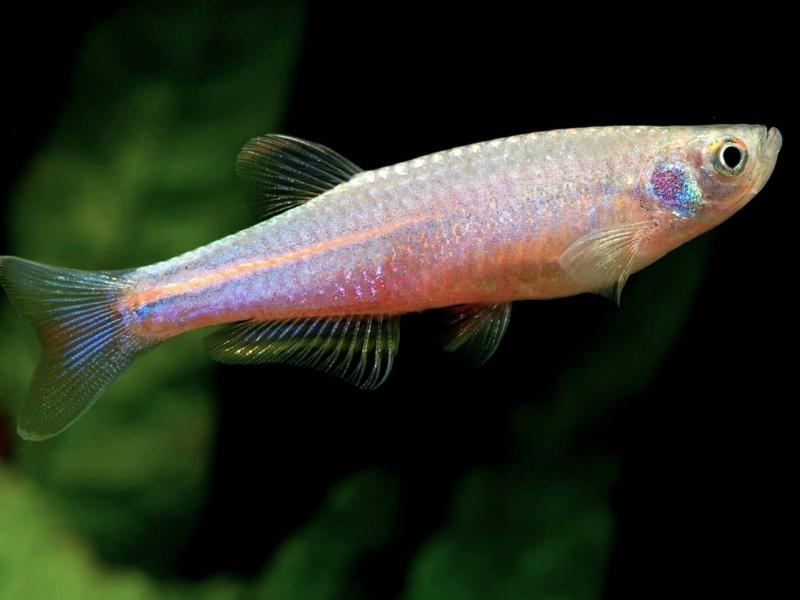
| Care level: | Temperament: | Color: | Lifespan: | Size: |
| Easy | Peaceful | Variable, brown, yellow, or pink coloration, orange stripe, iridescent | 5 years | Up to 2 inches |
| Water temperature: | Water pH: | Tank size: | Diet: | Scientific name: |
| 68 to 77°F | 6 to 8 pH | 10 gallons | Omnivore | Danio albolineatus |
The pearl danio’s most defining feature is its iridescent, pearly-blue scales. An orange stripe spans across the fish’s body, and the fish comes in a variety of colors, tones of brown and pink to yellow and silver.
Pearl danios originate from the fast-moving streams and rivers in Thailand, Sumatra, and Myanmar. Although they are often confused, pearl danios are different species from celestial pearl danios.
Pearl danios suit community tanks well because of the fish’s gentle and hardy nature, but despite their hardiness, pearl danios need well-oxygenated water.
Improve oxygen levels with a good filtration system and an elongated tank. Overhead lighting lets the pearl danio’s iridescent hues shine.
Rose Danio
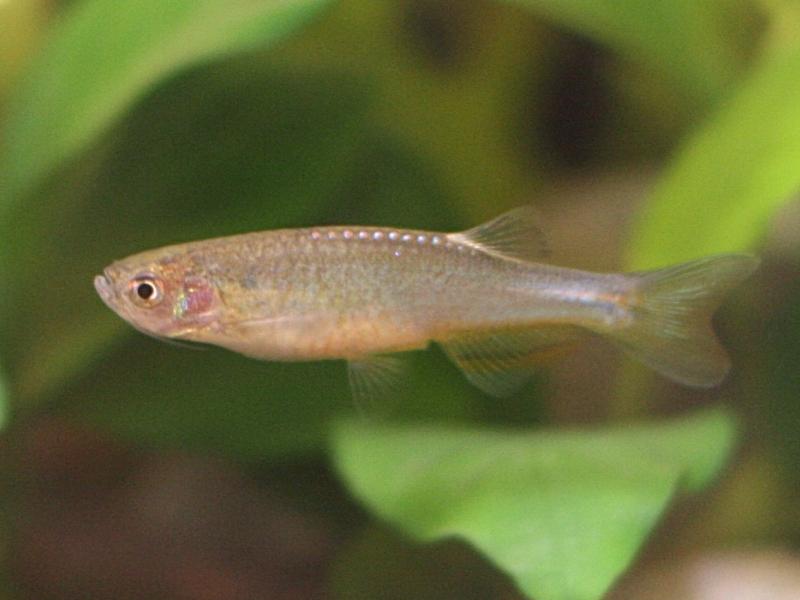
| Care level: | Temperament: | Color: | Lifespan: | Size: |
| Easy | Peaceful | Pink, iridescent | 3 years | Up to 2 inches |
| Water temperature: | Water pH: | Tank size: | Diet: | Scientific name: |
| 68 to 77°F | 6 to 7.5 pH | 10 gallons | Omnivore | Danio roseus |
The rose danio is a small fish that gets its name for its attractive pink coloration and rosy underside.
In the wild, rose danios are native to Laos, Thailand, and Myanmar. They are commonly found in running streams and rivers shaded by trees.
Rose danios enjoy swimming against the current and require a well-oxygenated aquarium with moderate water flow.
These danios are particularly sensitive to water changes and need ideal water conditions to live happily.
Ideal tank mates for rose danios include small, lively fish that can keep up with the rose danio’s fast swimming pace.
Zebra Danio
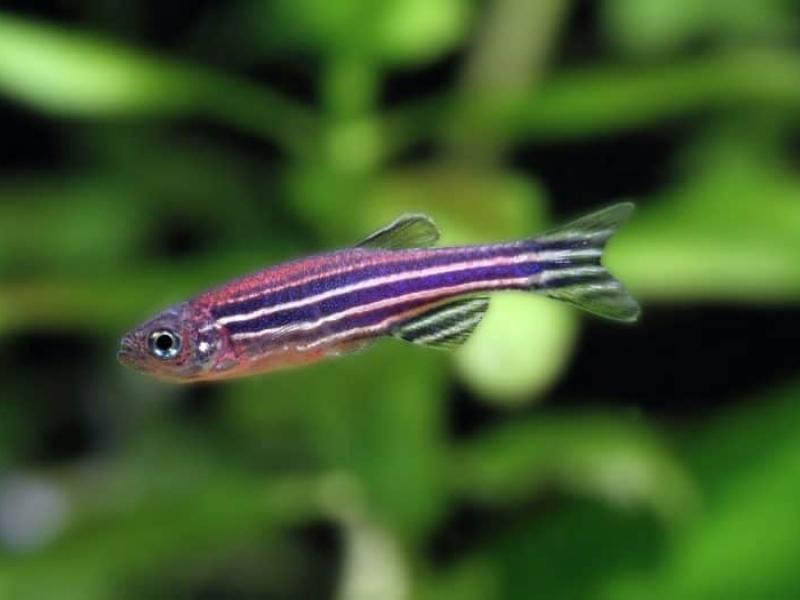
| Care level: | Temperament: | Color: | Lifespan: | Size: |
| Easy | Peaceful, sometimes aggressive (fin nippers) | Silver with blue stripes, several color morphs | 5 years | Up to 2 inches |
| Water temperature: | Water pH: | Tank size: | Diet: | Scientific name: |
| 64 to 77°F | 6.0 to 8 pH | 10 gallons | Omnivore | Danio rerio |
The zebra danio has silver coloration with distinctive blue stripes that span from head to caudal fin.
Several color morphs of the fish exist, including the popular albino morph and gold morph. There are also selectively bred variations of the zebra danio, such as the longfin zebra danio, which has elegant, flowing fins.
Zebra danios are hardy and thrive in a wide range of habitats in the wild, from rice paddies to slow-moving streams. The fish is native to South Asia, particularly India and Bangladesh.
Although zebra danios are social, the fish exhibit aggression toward long-finned or slow-moving species.
Keep zebra danios with fish that can match this danio’s lively attitude and speed. Replicate the zebra danio’s natural habitat with pebbles, bogwood, and freshwater plants like Java fern.
Choosing & Caring For Different Types of Danios
Danios are attractive, easy to care for, and peaceful. Most danios tolerate a range of water conditions, making the fish a good choice for beginner fishkeepers.
However, danios need to be in groups of at least six to feel safe and secure. In a group, danios become confident and display captivating shoaling behaviors.
Keep danios healthy and happy with good filtration and regular water changes (25% weekly).
Inexperienced fishkeepers should avoid timid danios, like celestial pearl danios, and danios sensitive to water fluctuations, such as rose danios.
Several danio species are jumpers, so investing in a secure tank lid is essential.
Danios are great dither fish and well-suited to community tanks, though certain species, like the panther danio, display fin-nipping behavior, and should not live in an aquarium with long-finned fancy fish.
Different types of danios can live together, as long as the tank is spacious and the danios share similar water parameter preferences.

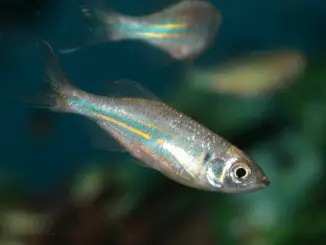
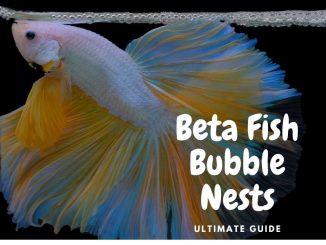
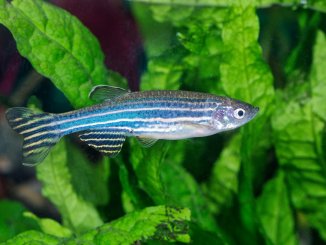
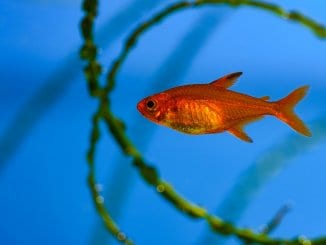
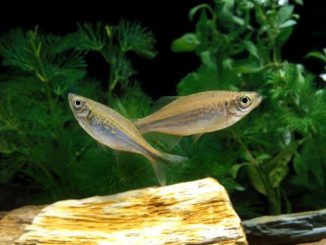
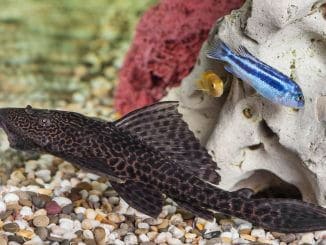
I just got zebra danios 3 days ago, this is 4th day, a dozen. When I bought it from market they were builsh green with dark blue stripes. Since I bought they’re getting dark, now they’re not bluish green…… they’re somewhat deep green like plant leaf, and the stripes are almost black with distinct golden borders of stripes. They do not school whatsoever, they move everywhere, they eat like they’ve never eaten anything and moves like they’ve ADHD. Is the color change normal ?